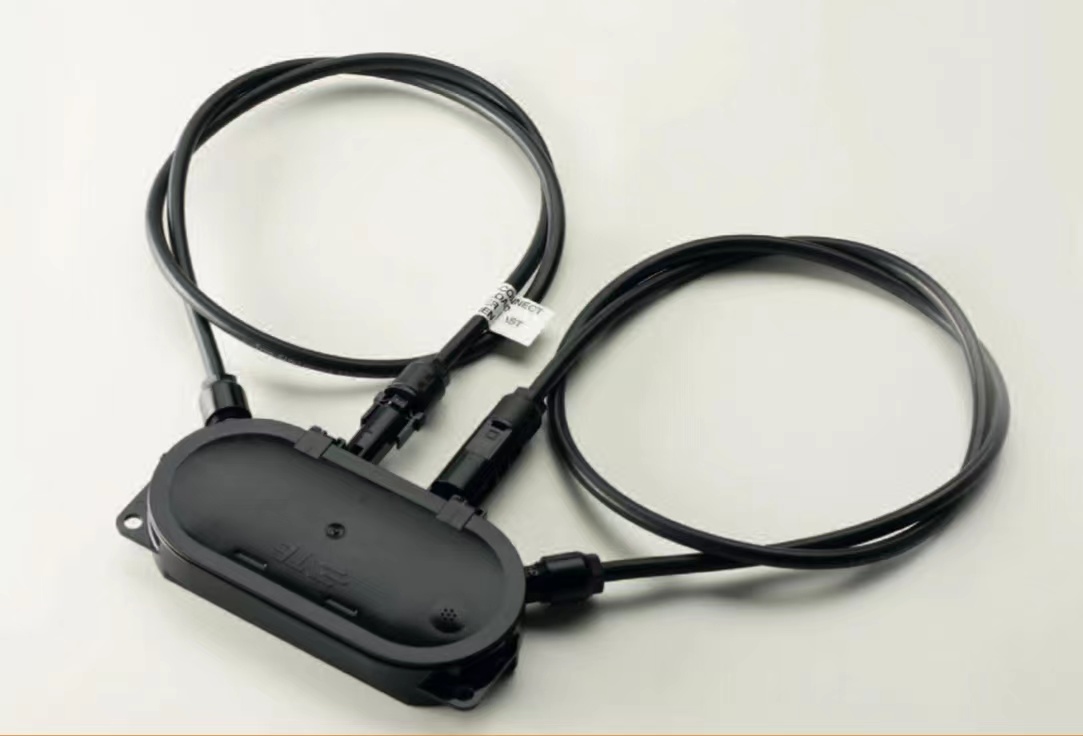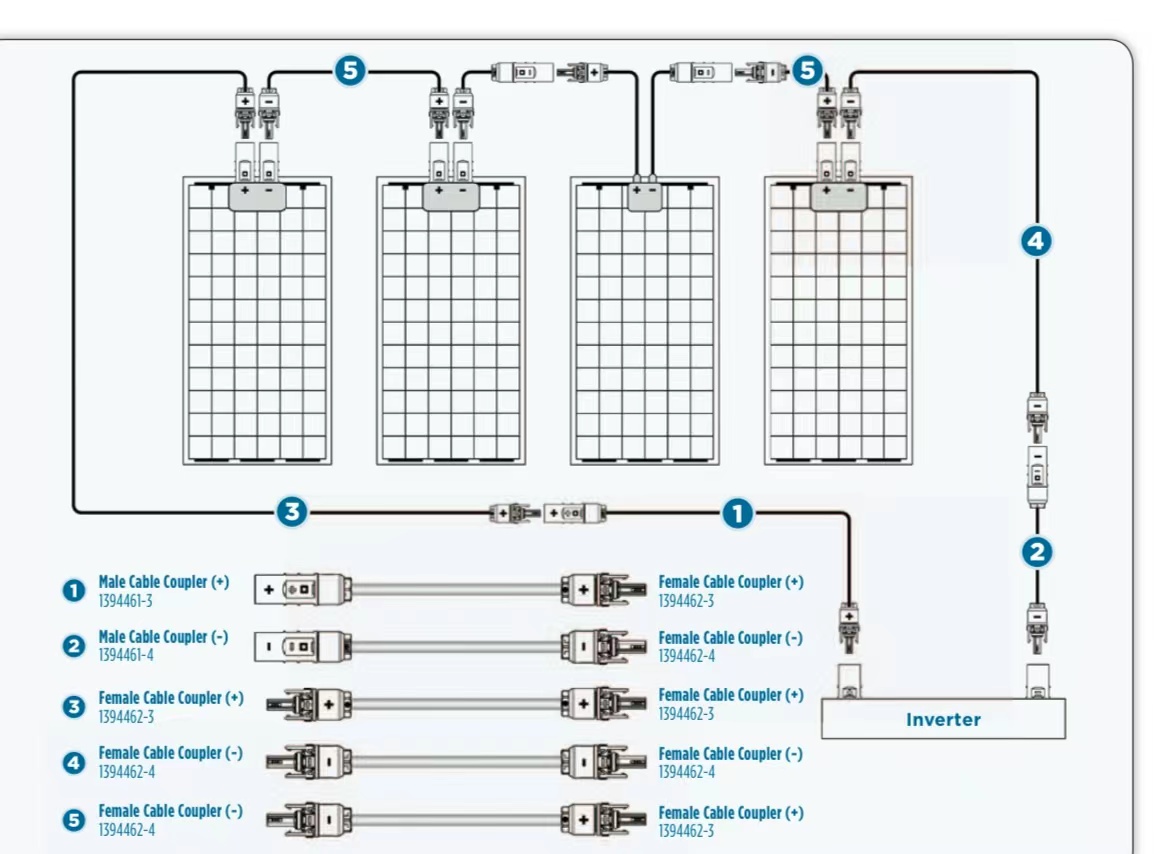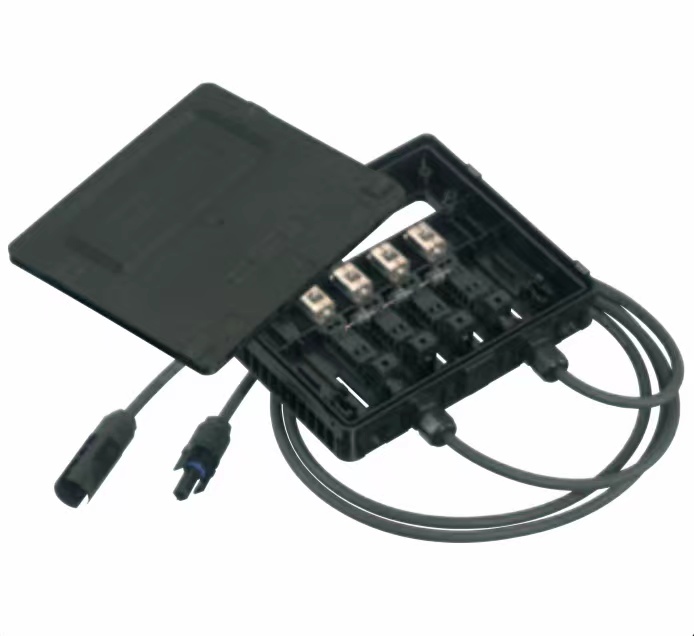What is a Photovoltaic (Solar Panel) Connector?

What is a Photovoltaic (Solar Panel) Connector?
A Photovoltaic (Solar Panel) Connectors is an electrical connector used in solar power generation systems to connect solar panels, inverters, and other electrical components. Photovoltaic connectors ensure efficient energy transfer and minimize any power loss in the system.

How does a photovoltaic connector work?
Photovoltaic (Solar Panels) Connectors is a special connector used to connect photovoltaic modules and other electrical equipment, and its main principle is to convert solar light into direct current energy and transmit it to the inverter or grid for storage or use.

What are Solar Panel made of?
1. Plug : The plug is a part of the connector, usually the output connector of the solar panel. It usually has metal pins or contacts that are used to transmit current.
2. Socket : The socket is another part of the connector, usually the connector of the inverter or other electrical components. The socket is paired with the plug to form an electrical connection. Receptacles usually also have metal pins or contacts.
3. Locking mechanism: In order to ensure the firmness and stability of the connector, many solar connectors are equipped with a locking mechanism. The locking mechanism can be swivel, push-pull, or other forms to lock the plug and socket together, preventing accidental falling off or loosening.
4. Insulating sleeve: The insulating sleeve is usually located between the plug and socket of the connector and is used to isolate and protect the metal pins from short circuit and galvanic isolation failure. Insulating sleeves are usually made of materials with good high temperature resistance, weather resistance and insulating properties.
5. Sealing ring: Since solar connectors are usually used in outdoor environments, they need to have the ability to be waterproof and dustproof. The sealing ring is located between the plug and receptacle of the connector and provides a water- and dustproof seal that protects the connector from the environment.

What are the advantages of photovoltaic connectors?
1. High reliability: Photovoltaic (Solar Panel) Connectors have high temperature resistance, humidity resistance, and waterproof performance to ensure long-term operation in unfavorable environments.2. Easy to disassemble: The Photovoltaic (Solar Panel) Connectors is easy to plug and unplug, and the operation is simple, thus reducing the difficulty and cost of installation and maintenance.
3. Low Insertion Force: The insertion force should be small to ensure that the connector does not cause damage to other parts of the connector when mating and unplugging.
4. Low contact resistance: The contact resistance of the Photovoltaic (Solar Panel) Connectors is low to ensure that the photovoltaic power generation device can produce the maximum power generation efficiently
5. High heat resistance: The material of the Photovoltaic (Solar Panel) Connectors has good heat resistance to ensure that there is no deformation, no expansion, and no melting in a high-temperature environment for a long time
6. Good sealing: easy to plug and connect, easy to overhaul and maintain.
7. It can work under harsh environmental conditions and is suitable for various environments.
8. It has good thermal and electrical conductivity, safe, reliable and durable.
9. Standardized, modular, maintenance-free design, can be flexibly combined, and has high versatility.
What fields can photovoltaic connectors be applied to?
Photovoltaic (Solar Panel) Connectors are mainly installed on photovoltaic solar panels, so they can be applied to the following fields:
The application of photovoltaic solar energy in the field of domestic residence is mainly focused on household electricity and hot water supply. Home photovoltaic systems convert solar energy into direct current by installing photovoltaic panels, which in turn converts it into alternating current through an inverter. A home PV system can provide electricity to the home and inject the excess electricity into the grid for sale.
In addition, photovoltaic solar energy can also be used for hot water supply. Solar water heaters utilize photovoltaic panels to absorb solar energy and convert it into hot water using a heat exchanger. It not only saves energy, but is also environmentally friendly.
In the field of commercial buildings, photovoltaic solar energy is widely used on roofs and walls to power commercial buildings. In urban, commercial and industrial areas, photovoltaic solar energy plays an important role in grid peak shaving. In addition, photovoltaic solar energy can also be used in ground-mounted power stations to provide more power supply to commercial areas.
Photovoltaic solar energy can also be used for road lighting and traffic signals. Road lights can be reduced by installing photovoltaic panels for energy conversion. Traffic lights can avoid power interruptions and improve traffic safety at intersections through photovoltaic solar technology.
Large-scale solar power plants typically consist of hundreds or even thousands of photovoltaic modules, and connectors are critical for the stability of power transmission and system efficiency.

Connectors for solar charging piles and photovoltaic carports are used not only to connect to the grid, but also to connect photovoltaic modules and charging equipment.
6. Agricultural aquaculture
In the field of agricultural farming, photovoltaic solar energy can provide clean, renewable energy for farms. Through the installation of photovoltaic panels, solar energy is converted into electricity to feed light sources, water pumps, ventilation systems and other equipment to improve the efficiency and quality of aquaculture.What are the types of photovoltaic connectors?
Depending on the type, form, and use of the connector, PV connectors can be divided into multiple classifications.
In-line connectors are a universal connector type that is commonly used in low-power photovoltaic systems. In-line connectors are usually made of metal conductors and insulating materials, which have good electrical conductivity and weather resistance.
PCB connectors are connected by connector and receptacle for quick disassembly and connection. Plug-in connectors are widely used in high-power photovoltaic systems such as large-scale photovoltaic power stations and centralized combiner boxes of photovoltaic power stations.
The MC4 connector is one of the most commonly used connectors for polycrystalline solar panel components. Because of its easy installation, good waterproofness, high temperature resistance, corrosion resistance and other characteristics, it is widely used in photovoltaic power plants. The MC4 connector consists of three parts: the connector body, the inner core and the rivet. The main materials of the connector include PPO, PA66, etc.
Tyco connector is a connector used more in the field of photovoltaic power plants, and it is also the predecessor of MC4. Tyco connectors are made of excellent materials, have a long service life, and have good cold resistance and a wide range of operating temperatures. After years of practice and application, Tyco connectors have been gradually replaced by MC4.
What is the difference between MC3 and MC4 connectors?
The Arabic numerals mean the diameter of the metal cable, and MC is the model number of the connector.1. MC4 connector MC4 connector is the most commonly used photovoltaic module connector in the market, which adopts the socket locking structure, which has the advantages of light plugging, large contact area, waterproof sealing and so on. In the process of installation and use, the use of MC4 connector can effectively reduce the number of indirect heads of the module, improve the installation efficiency and module performance, and is one of the indispensable components in the modern photovoltaic power station.
Are Photovoltaic (Solar Panel) Connectors universal?
It is not necessarily universal, it depends on the size and the manufacturer and category of the connector.How should I install a photovoltaic connector?
When installing a PV connector, the following steps are generally followed:1. Preparation
Before starting the installation, make sure all the required materials and tools are in place. These materials include photovoltaic connectors, connecting cables, sealants, tools such as wire strippers, torque wrenches, etc.
2. Inspect the connector
First check that the connector is intact and that there is no obvious physical damage or falling off. Make sure the pins and slots are clean and free of dust or impurities.
3. Strip the cable
Use the wire stripper to strip the outer insulation of the connecting cable according to the requirements of the connector, and expose the internal wire. Make sure that the length of the strip and the part of the strip meet the requirements of the connector.
4. Mounting Pins
Insert the pins into the end of the wire connecting the cable according to the polarity of the connector. Make sure that the contact between the pin and the wire is good and tightened.
5. Plug in the connector
Insert the connecting cable into the slot of the connector, making sure the pins are properly inserted into the slots, gently pushing in until they are fully inserted, and making sure that the metal contact between the pins and the slots is good.
6. Check and fix
Check whether the pins and slots of the connector are fully inserted and there is no loosening or falling off. Using a torque wrench, tighten the threaded portion of the connector appropriately according to the torque requirements provided by the connector manufacturer.
7. Sealing treatment
Use appropriate sealant or gasket to seal the connector to ensure waterproof and dustproof effect.
8. Organize your cables
Organize your connecting cables to make sure they don't have excessive tension or bending, and keep them neat and organized.
9. Test the connection
Once the connection is complete, conduct a comprehensive security check. Make sure the connection is secure, the cable is not exposed, and there is no damage or aging. Check that the connectors and cables are tightly connected to the photovoltaic panels.
System tests are carried out to ensure that the photovoltaic panels are capable of generating electricity normally and that the inverter is capable of converting direct current to alternating current. Observe the operation of the system and check whether there are any abnormal phenomena. Proper connections ensure efficient and stable operation of the system, and all connections should be strong and reliable to ensure the safety and reliability of the system.






